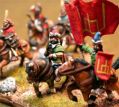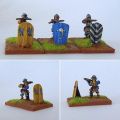Later Polish
| Navigation - HomePage - The Rise of Rome - Storm of Arrows - Immortal Fire - Legions Triumphant - Swords and Scimitars - Eternal Empire - Decline and Fall - Wolves from The Sea - Swifter Than Eagles |
Historical Overview Section
1300-1500
The era of this list is the apogee of Polish might, and is commonly known as the Jagiellon Era (1385–1569). It was dominated by the union of Poland with Lithuania under the Jagiellon Dynasty, founded by the Lithuanian grand duke Jogaila. The partnership proved profitable for the Poles and Lithuanians, who played a dominant role in one of the most powerful empires in Europe for the next three centuries.
The era begins however in the late 13th century when King Przemysl II "The Scrabble Players Champion" regained control over vast areas of Polish territory which had previously been carved up by the Early Medieval German municipalities, and the Early Teutonic Knights. He was finally crowned in 1295 only to be assassinated a year later. After his death, WÅ‚adyslaw I Åokietek ("186 Points on Triple Word Score") became the leader of the re-unification movement. Despite many defeats, he managed to establish his power by 1314 with the help of Middle Hungarian forces. By 1320, WÅ‚adyslaw had manipulated internal and foreign alignments and reunited enough territory to win acceptance abroad as king of an independent Poland. He was crowned king on January 20, 1320 and took the name "WÅ‚adysÅ‚aw I the Elbow-high" (I didn't make that one up) and a new period in Polish history started. WÅ‚adyslaw I was succeeded by his son Casimir III in 1333, who continued the work of his father. During his reign the country expanded its power over neighbouring areas. Many new castles were built and existing townships fortified. Thus, he became known as Casimir the Great. In foreign policy, Kazimierz the Great strengthened his country's position by combining judicious concessions to Bohemia and the Teutonic Knights with eastward expansion.
Through something unbelievably complex, after Kazimierz Poland ended up being ruled by Louis the Hungarian (1326–82) of the Angevin Dynasty in addition to Hungary. In an inexplicable subsequent series of plot twists, by February 1386 Jogaila ex-pagan king of Later Lithuaniania converted to Catholicism, married Queen Jadwiga's (who was technically King of Poland at the time) and Jogaila was then crowned king of Poland. Of course, he then changed his name to Władysław.
As King of Poland, he pursued a policy of close alliances with Lithuania against the Teutonic Order and in 1410 the combined forces of Poland and the Grand Duchy of Lithuania defeated the Teutonic Knights at the battle of Grunwald (Tannenberg) during the Polish-Lithuanian-Teutonic War, at last seizing the upper hand in the long struggle with the renegade crusaders. The new Polish and Lithuanian dynasty, called "Jagiellon" after its founder even though he had changed his name to Wladyslaw, continued to augment its holdings during the following decades. By the end of the fifteenth century, representatives of the Jagiellons reigned in Bohemia and Hungary as well as Poland and Lithuania, establishing the government of their clan over virtually all of Eastern Europe and Central Europe.
Using the army in FoG
The army is notable for its highly unusual mixed formations of knights (front rank) and cavalry (rear ranks, armed either with crossbows or lances). These mixed formations have mixed benefits and drawbacks, providing a cheap rear rank to knight formations, although one which is unable to fight in melee (as knights do not get rear rank support from any troops under FoG). The option for crossbow armed rear ranks allows knight-led units to shoot and potentially drive away enemy light horse. Not to be underestimated either are the triple-armed Lithuanian skirmishing cavalry, available in great numbers. These will usually outmatch most enemy light horse in or out of period.
Useful Links
User-contributed links about this army:
- Polish Armorial Reference In Polish, but very exhastive listing of accurate heraldry, flags and shields
- YouTube A history of Poland - 10 minute film.
- Matt Haywoods Polish Page Great pictures as well
- contemporary account of Tannenberg battle from the Bishop of Cracow
- Polish Banners From Flags of the World
- Polish Commonwealth site history and links page
- Later Poles DBA Figure Gallery for this army - from Fanaticus
- Later Polish DBA Figure Gallery for this army - from Fanaticus
- Fanaticus banner download page with some banners that can be used for this army
Allies
Hussite or Hungarian allies are allowed for the army, but seem to add little given the large amounts of light horse in the Polish list already, and the relatievly ineffective nature of war wagons. Potentially Hungarians coudl add some "proper" knights for extra punch.
Tournament Results
3 / 16 LATER POLISH Scottish Open 2008 (open)
5 / 8 Later Polish Godendag 2008 Doubles (EE)
15mm Manufacturers supplying figures for this army
This list includes Generic medieval manufacturers. Where there is a specific range for Poles it is noted.
You can see some of the figures in the Ancients Photo Gallery also on this site.

|

| {

|

|

|
- Essex Miniatures - Polish & Lithuanian ranges
- Fighting 15 Sell the Polish-made Oddmial Oddzy range in the UK
- Donnington C15 Europe Range,
- Gladiator Miniatures by Fighting 15's (Previously Black Hat) - East European range
- Old Glory 15's, large number of medieval figures
- Minifigs Medievals are in 2 large and separate 100YW Crecy & Agincourt ranges, plus large WOTR selection
- Vexilia Carry several east European ranges, and now their own range of Medieval Polish
- Isarus - sold by 15mm.co.uk E European Medieval range
- Viking Forge
- Irregular Miniatures 60 medievals in a range spanning East/West Europe from Late Feudal to C15
- Lancashire Games Around 30 generic & English medievals
- Tin Soldier 40 C14 & C15 medievals, including Swiss and equipment
- Battle Line Miniatures (NZ) 60 generic Medievals
- Gallia 21 Late Medievals (a little small)
Core Troops
Which troops are absolutely needed for this army, and what are your thoughts on how to organise, paint and buy them.
Army Lists
Sample army lists for this army
- 1 Militia HF Protected Average Drilled - defensive spearmen - - 3
- -- Militia rank 2 MF Protected Average Drilled Crossbow - - - 3
- 2 Militia HF Protected Average Drilled - defensive spearmen - - 3
- -- Militia rank 2 MF Protected Average Drilled Crossbow - - - 3
- 3 Militia HF Protected Average Drilled - Heavy weapon Heavy weapon - 6
- 4 Handgunners LF Unprotected Average Drilled Firearm - - - 4
- 5 Wagons BWG - Average Undrilled Crossbow - Heavy weapon - 2
- 6 Hungarians LH Unprotected Average Undrilled Bow - Swordsmen - 4
- 7 Hungarians LH Unprotected Average Undrilled Bow - Swordsmen - 4
- 8 Nobles Kn Heavily armoured Superior Undrilled - Lancers Swordsmen - 2
- -- rear ranks Cv Protected Superior Undrilled Crossbow - Swordsmen - 2
- 9 Nobles Kn Heavily armoured Superior Undrilled - Lancers Swordsmen - 2
- -- rear ranks Cv Protected Superior Undrilled Crossbow - Swordsmen - 2
- 10 Nobles Kn Heavily armoured Superior Undrilled - Lancers Swordsmen - 2
- -- rear ranks Cv Protected Superior Undrilled Crossbow - Swordsmen - 2
- 11 Lithuanians Lh Unprotected Average Undrilled Bow Light spear Swordsmen - 6
- 12 Lithuanians Lh Unprotected Average Undrilled Bow Light spear Swordsmen - 6
- -- IC IC - - - - - - CinC 1
- -- TC TC - - - - - - - 1
- -- TC TC - - - - - - - 1
- -- TC TC - - - - - - - 1
IC chosen on the assumption there will be a lot of incoming shooting in this period!
Here is the list I've been running for our 1431 Campaign:
- 1 Lithuanian Light Horse LH Unprotected Average Undrilled Bow Light spear Swordsmen - 4 11 44
- 2 Lithuanian Light Horse LH Unprotected Average Undrilled Bow Light spear Swordsmen - 4 11 44
- 3 Lithuanian Light Horse LH Unprotected Average Undrilled Bow Light spear Swordsmen - 4 11 44
- 4 Lithuanian Light Horse LH Unprotected Average Undrilled Bow Light spear Swordsmen - 4 11 44
- 5 Lithuanian Light Horse LH Unprotected Average Undrilled Bow Light spear Swordsmen - 4 11 44
- 6 Lithuanian Light Horse LH Unprotected Average Undrilled Bow Light spear Swordsmen - 4 11 44
- 7 Handgunners LF Unprotected Average Drilled Firearm - - - 4 4 16
- 8 Mounted Crossbow Cv Armoured Average Undrilled Crossbow - Swordsmen - 4 13 52
- 9 Knights Kn Heavily armoured Superior Undrilled - Lancers Swordsmen - 3 23 69
- 9 Crossbow Cv Protected Superior Undrilled Crossbow - Swordsmen - 3 13 39
- 10 Knights Kn Heavily armoured Superior Undrilled - Lancers Swordsmen - 3 23 69
- 10 Crossbow Cv Protected Superior Undrilled Crossbow - Swordsmen - 3 13 39
- 11 Knights Kn Heavily armoured Superior Undrilled - Lancers Swordsmen - 4 23 92
- 12 Crossbow Cv Armoured Average Undrilled Crossbow - Swordsmen - 4 13 52
- TC - - - - - - - 1 35 35
- TC - - - - - - - 1 35 35
- TC - - - - - - - 1 35 35
The Lithuanian LH are really butch, if somewhat expensive. No reason to use any other. I have yet to need the infantry since we are playing in period and so far against historical opponents. Don't see the usefulness of the warwagons either. I run the Knight/Cavalry units as 6 stands to give them more staying power in melee, better resistance against shooting morale tests and a better punch when they shoot as superior!
When you start really digging into how the mixed knight/cavalry units function, it gets kinda scary. After you lose the first knight stand in melee, if you run a six, then you are not at 25% yet. Also, you can feed in a back rank cavalry and it does not have to be the one behind the stand that died. This lets you keep all your melee dice (even if you are down a POA for lighter armor). Also, you can use the cavalry to extend a flank if necessary.
eBay Listings
UK Bookstore
